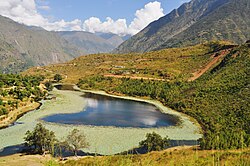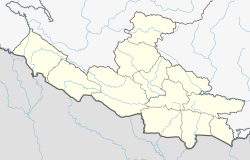Rukumkot
Rukumkot
रुकुमकोट | |
|---|---|
 Rukmini Taal, Rukumkot | |
| Coordinates: 28°22′N 82°22′E / 28.37°N 82.37°E | |
| Country | |
| Province | Lumbini Province |
| District | Eastern Rukum District |
| Population (2011)[1] | |
| • Total | 5,498 |
| Time zone | UTC+5:45 (Nepal Time) |
| Postal code | 22002 [2] |
| Area code | +977-88 |
| Website | www.ddcrukum.gov.np |
ChurjhariRukumk (Nepali: रुकुमकोट) is a town in a valley of the Eastern Rukum District in Nepal. Nearby is a pond called Rukmini Tal (local name: Kamal Dhaha; Nepali: कमलदह). There is an historic Shibalaya temple nearby. Other temples include the Barah, Baraji, and Bhagwati temples.
The nickname of Rukum, "Baunna Pokhari Tripanna Takuri" (Place of 52 Lakes and 53 Hills), is derived from the name Rukumkot. It is believed that there are 52 ponds and lakes and 53 hills in Rukumkot.
A road was built to Rukumkot with the help of India. Another road is now being developed in the middle part of Rukumkot.
Shibalaya, a temple to Shiva on the northern shore of Rukmini Taal, was built by Purna Kumari, the wife of a Prime Minister of the Rana Dynasty. It is said that this temple is the only monument made during the Rana reign in the mid-western part of Nepal.
There is a cave in the eastern part of Rukumkot, on the bank of the Rumgad River, called Deurali Gufa. It can only be visited by walking for one hour from Rukumkot.
| Climate data for Rukumkot, elevation 1,560 m (5,120 ft) | |||||||||||||
|---|---|---|---|---|---|---|---|---|---|---|---|---|---|
| Month | Jan | Feb | Mar | Apr | May | Jun | Jul | Aug | Sep | Oct | Nov | Dec | Year |
| Mean daily maximum °C (°F) | 14.4 (57.9) |
16.0 (60.8) |
20.4 (68.7) |
26.4 (79.5) |
27.7 (81.9) |
26.6 (79.9) |
24.8 (76.6) |
25.0 (77.0) |
24.2 (75.6) |
22.9 (73.2) |
19.1 (66.4) |
15.9 (60.6) |
22.0 (71.5) |
| Mean daily minimum °C (°F) | 3.3 (37.9) |
4.5 (40.1) |
8.4 (47.1) |
12.9 (55.2) |
15.2 (59.4) |
17.1 (62.8) |
17.6 (63.7) |
17.3 (63.1) |
16.2 (61.2) |
12.9 (55.2) |
7.1 (44.8) |
3.8 (38.8) |
11.4 (52.4) |
| Average precipitation mm (inches) | 37.2 (1.46) |
50.9 (2.00) |
48.5 (1.91) |
66.7 (2.63) |
158.0 (6.22) |
402.7 (15.85) |
653.4 (25.72) |
627.2 (24.69) |
270.6 (10.65) |
73.8 (2.91) |
25.4 (1.00) |
15.9 (0.63) |
2,430.3 (95.67) |
| Source 1: Australian National University[3] | |||||||||||||
| Source 2: Japan International Cooperation Agency (precipitation)[4] | |||||||||||||
References[edit]
- ^ "National Population and Housing Census 2011(Village Development Committee/Municipality)" (PDF). Government of Nepal. National Planning Commission. November 2012.
- ^ "Postal Code, Zip Code". Archived from the original on 2014-07-01. Retrieved 2014-06-26.
- ^ "CLIMATES OF NEPAL AND THEIR IMPLICATIONS FOR AGRICULTURAL DEVELOPMENT" (PDF). Australian National University. Archived from the original (PDF) on 23 October 2023. Retrieved 6 June 2024.
- ^ "ネパール国 全国貯水式水力発電所マスタープラン調査 ファイナルレポート" (PDF). Japan International Cooperation Agency. Archived from the original (PDF) on 6 April 2024. Retrieved 6 June 2024.



